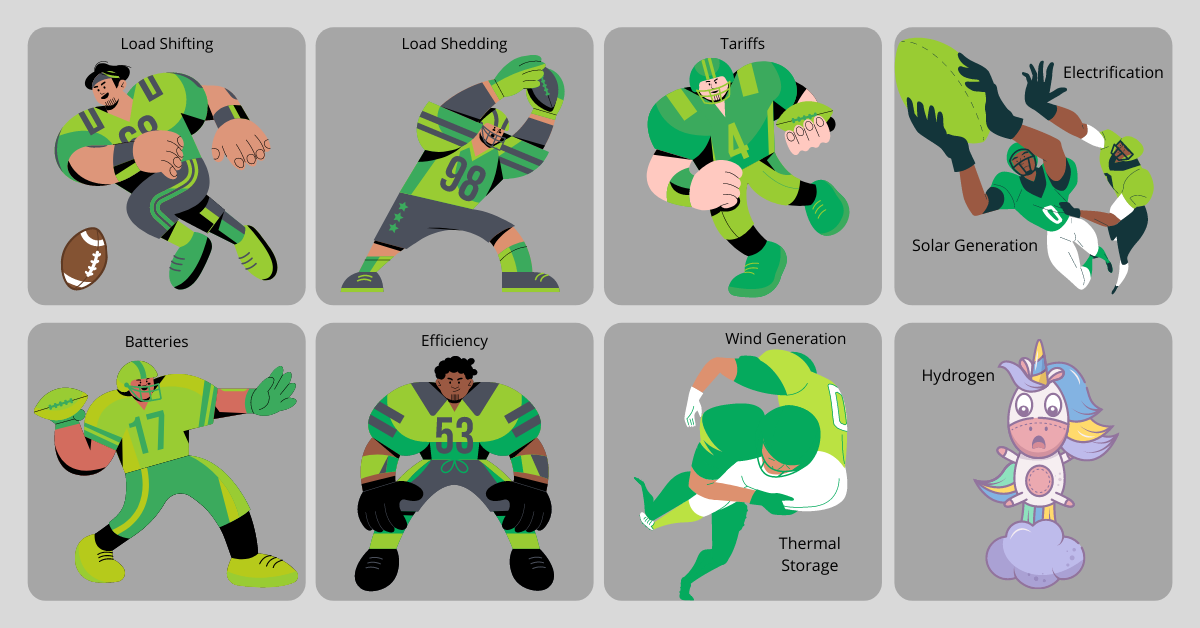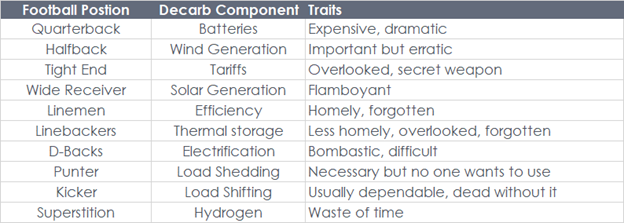
About every six months, while participating in a strategic planning, leadership, marketing, or business development meeting, I hear “we should be doing decarb,” or “we’ve been talking about decarb for years, and that’s all we do is talk about it.” “We’ll be right back here talking about it a year from now.”
Whoa! First, what is decarb? My guess is most people would say reducing the consumption of hydrocarbons in a catalytic process with airborne oxygen to produce heat which may be used for heating, power generation, or locomotion – while producing coproducts of gaseous water, carbon dioxide, and minuscule volumes of other gases.
That’s easy, but how is decarbonization achieved? There are billions of moving parts and needs. It’s a little like a football team. A team consisting of only quarterbacks will be crushed unless maybe the opponent is da Bearsss! Oh! A team of guards and tackles will get blown away. You get the picture.
The best decarb strategy includes a mix of talent (quarterback), speed (receivers), quickness (defensive backs), athleticism (tight ends and linebackers), power (linemen), flexibility (kickers), and superstition. I paired all these positions with their twins on the decarb team and described how they compare in the value stack.
 Batteries
Batteries
Batteries suck up a lot of attention in the decarb dialogue. They are like the quarterback drama queens. They cost a fortune, and it is hard to go all the way if your quarterback sucks. Front office of the Minnesota Vikings – hear me good. I don’t understand why the power sector is obsessed with lithium-ion batteries, which cost a fortune because they require 500,000 lbs of raw material (250 tons, or 8.3 semi-trailer loads) to make one measly Tesla car battery. Such a battery can store about 60 kWh. For four hours, it provides a whopping 15 kW for about $10,000. But then, a Finnish fellow was given an opportunity to replace his Tesla S battery for $22,000. He rejected the bid, and he released his sentiment as follows (click the image below for an explosive video).  Don’t miss the part where they throw Elon Musk out of the helicopter! Now that is liberation!
Don’t miss the part where they throw Elon Musk out of the helicopter! Now that is liberation!
Wind Generation
Wind generation is erratic and unpredictable. Turbines can churn power 24/X or 0/0. They can generate power for days or go dark for days. They are the running backs of decarb. The team with the best running back and top yardage back are rarely contenders – OJ Simpson, Barry Sanders, and Adrian Peterson.
Tariffs
As Arizona Public Service has demonstrated, tariffs or rate designs are potent weapons in decarbonization because they can affect behavior with positive customer experiences. It isn’t flashy, just like a tight end that can demoralize the other team. They block for a couple of seconds, slip into the backfield, catch the ball and pick up first downs by the fistful. Why can’t they stop that guy? It’s hard, man, and effective – like good tariff design.
Solar Generation
Solar generation by photovoltaic panels is probably more symbolic than the quarterback and batteries. Why? Everybody understands them, and some even think of them when they hear the term “energy efficiency.” I moderated a conference session a few years ago. The presentation included results of a survey which found that when consumers hear the term efficiency, 36% think of solar panels.
A few years ago, solar panels were a virtue-signaling status symbol – glamboyant (sic) like a prima donna wide receiver. Look what I did! As penetration has increased, the status symbol faded. You’re just a schmo now, unlike Antonio Brown.
Efficiency
Although it’s painful to say or ponder, efficiency is the least sexy of energy resources – like lineman with their guts hanging over their belt and their flabby buttocks. But they have power and amazing speed and agility for their size, which is a bit like efficiency.
Efficiency is consistently undercounted in utility integrated resource plans and regional transmission organization planning because[1]:
- Efficiency resources are not estimated with the same rigor as supply-side resources
- “Achievable” potential is capped by utility and regulator willingness to pay, and
- Unlike supply-side resources, efficiency is based on arbitrary benefit-cost tests and constrained by quotes
Thermal Storage
Thermal storage is to efficiency as linebackers are to pudgy linemen – it’s simple, very effective, essential, but slightly easier to understand than efficiency. Thermal storage is the alternative to expensive electrical storage. It’s also like prescriptive drugs – it’s been around forever with a long track record and is relatively inexpensive. Instead, engineers and business people pursue hyper-expensive and often dumb ways to store electricity. How’s that iron-air rechargeable battery coming along?
Electrification
Electrification is the mirror image (defensive backs taking on glamboyant receivers) of pricey electrical storage, and it gets similar attention. Why would that be? 1) Electrification is a major opportunity for electricity sales growth, and 2) Tesla. Like defensive backs, a wrong move or being overly aggressive with electrification will crash and burn the system. There is potential for much spikier and less-steady loads, including when the grid can least withstand it.
Load Shedding
Load shedding is like the punter. It’s nice to have a good one, but no one wants to see their punter in action.
Side story: When I was in grad school, I had season tickets to Badger football. It was shortly after they won the Rose Bowl, but that year, they sucked. On a fourth down, the Badger punter shanked the punt for about 15 yards, and my engineering pal shouted, “All he does at practice is punt the ball! How can you do that?” – it still kills me to this day.
For decarb, we must have the punter, load shedding for pay, but with an accompanying decrease in service, such as shivering, sweating, or reducing production.
Load Shifting
Load shifting is an up-and-comer with significant potential, in my opinion. It will be loyal, like a dog or the kicker. The ones that work will stay for a long time. Thermal energy storage, described above, is an excellent enabler of load shifting. Phase change materials that store thermal energy are charged when there is plenty of supply and discharged when there are constraints or energy supply is stressed.
Hydrogen
Finally, we have superstition, or unicorn farts, also known as hydrogen. To save some writing, check out Joel Gilbert’s post in which he writes: “I spent 6 years working for the leading new technology company that spearheaded the development of fuel cells. That was 45 years ago, and the catchphrase back then was they were “five years off” from commercialization. They are still not commercially viable.”
It Takes a Team – And Front Office
All these team members can contribute to decarbonization. However, a long-lasting front office, which would be nuclear power, is required to decarbonize the grid. There is no chance to decarb without nuclear. Zilch.
Want more on decarbonization? Ya gotta get to the AESP Spring Training event in Ponte Vedra, FL (not a bad place for an event…) where Jake Millette and I will be teaching our decarbonization course, Three-Legged Stool of Decarbonization, on May 18. Check it out here and get signed up!
[1] https://michaelsenergy.com/energy-efficiency-potential-studies-unnecessary-for-utility-2-0/
 Batteries
Batteries



